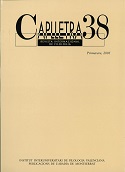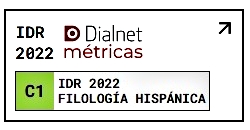Construcciones con avance estilístico en el catalán antiguo
DOI:
https://doi.org/10.7203/caplletra.38.4876Paraules clau:
construccions, català antic Resum
Resum
Stylistic Fronting is a phenomenon that has been intensively studied with respect to the symmetric Germanic Verb Second languages: Old/Modern Icelandic, Old/Modern Faeroese but also Middle English and Modern Yiddish. Standardly Stylistic Fronting is seen as an operation that moves an element in front of the finite verb in order to rescue the verb second constraint, in sentences that contain a subject gap. With the claim that the Old Romance languages are symmetric verb second languages, it soon followed that inverted elements in embedded contexts were analysed analogously to the Germanic inverted elements, i.e. as displaying Stylistic Fronting (Cardinaletti & Roberts 1991, Fontana 1993). In this paper I will present examples that show an nearly identical case of inversion in Old Catalan; nearly identical, because
in Old Catalan there are examples with stylistically fronted elements that don’t obey one of the formulated constraints of Stylistic Fronting: they appear next to a full subject. Furthermore, we find an interesting interplay between Stylistic Fronting and enclitic pronouns: not only that they disappear exactly at the same time in the history of Catalan, they also exclude each other during the time they were possible in Old Catalan. In this paper I hope to show that contrary to recent opinions Stylistic Fronting in Old Romance does have an effect on the information structure of the sentence comparable to the effect that topicalisation has on the information structural interpretation.
 Descàrregues
Descàrregues
Descàrregues
Publicades
Com citar
-
Resum413
-
PDF167
Número
Secció
Llicència
L’autor o autora que adrece un treball a la redacció de Caplletra perquè siga publicat ha de ser la persona titular legítima dels drets d'explotació. La legitimació per a la publicació del treball ha d’incloure també les imatges, les taules, els gràfics i altres materials que puguen complementar el text, amb independència de si n'és l'autor o autora.
Copyright. Quan publica el treball en la revista, l'autor o autora cedeix a Caplletra. Revista Internacional de Filologia els drets d'explotació (reproducció, distribució i comunicació pública), tant per a l'edició impresa en paper com per a la versió electrònica, que serà accessible mitjançant la xarxa Internet.
Tots els treballs publicats en Caplletra es troben sota una llicència Creative Commons del tipus Reconeixement-NoComercial-SenseObraDerivada 4.0.
RESPONSABILITAT
Caplletra. Revista Internacional de Filologia no s'identifica necessàriament amb els punts de vista mantinguts en els treballs que publica.
Caplletra. Revista Internacional de Filologia declina tota responsabilitat derivada de qualsevol vulneració eventual dels drets de propietat intel·lectual que poguera ser duta a terme pels autors o autores.






